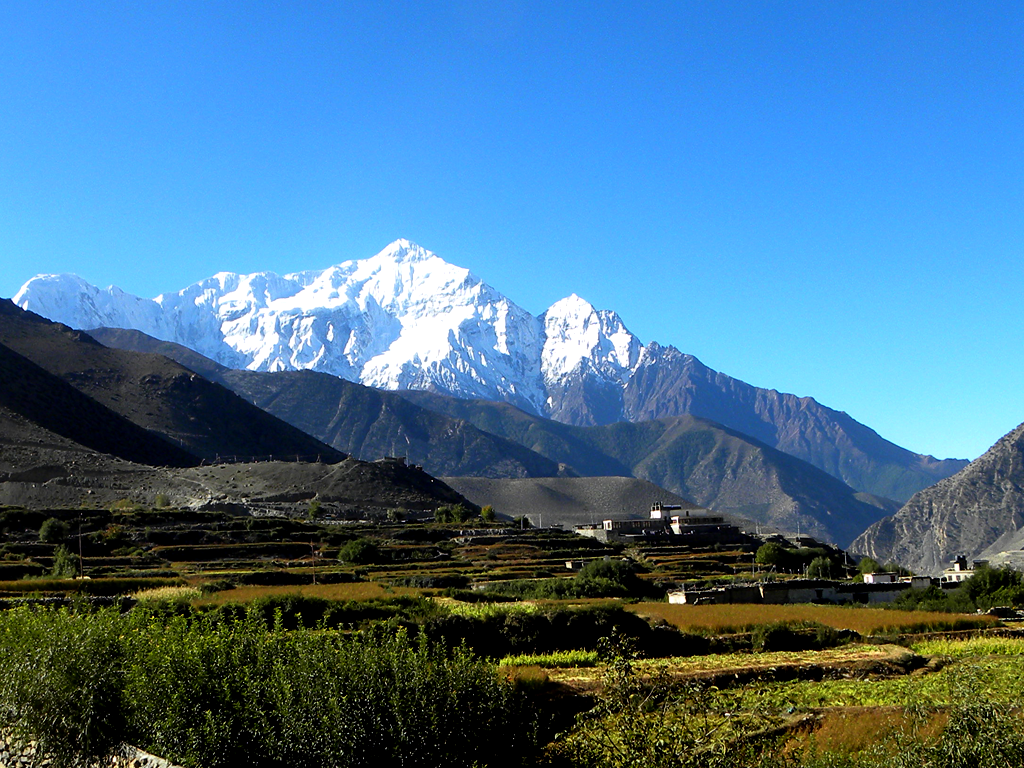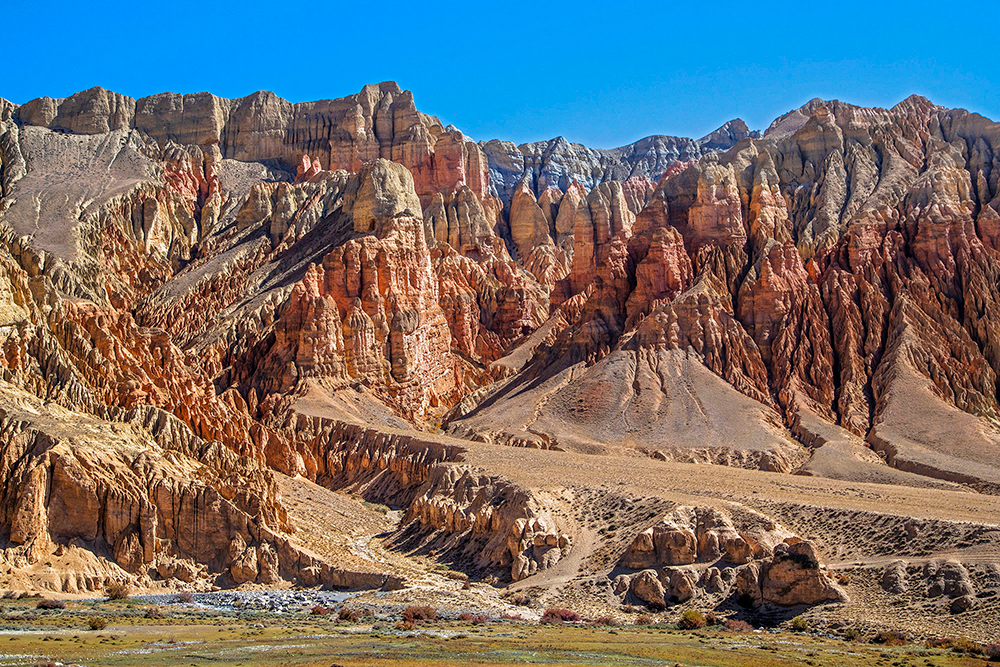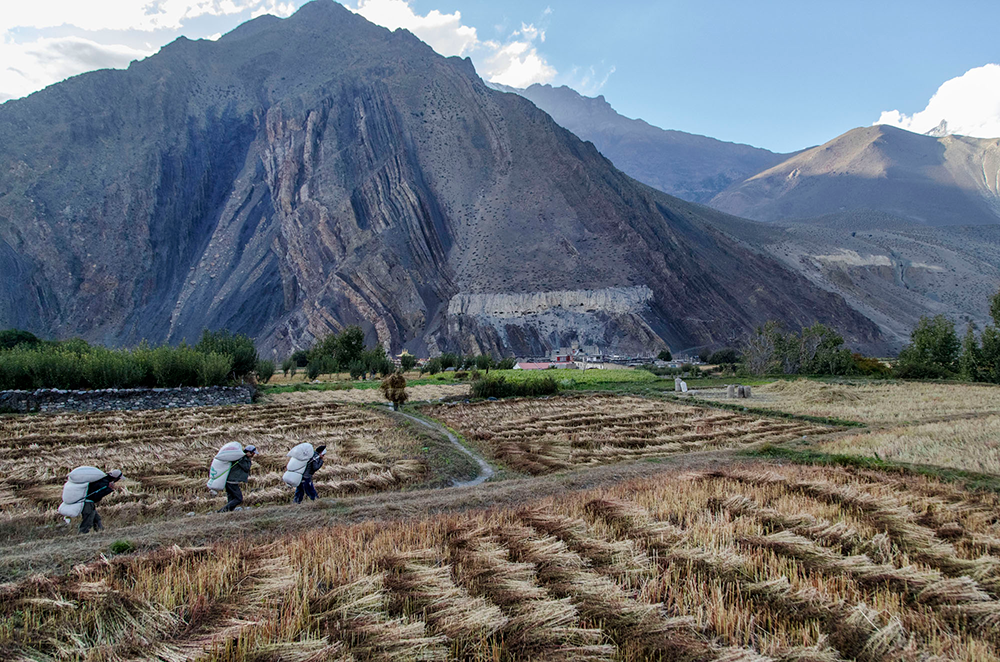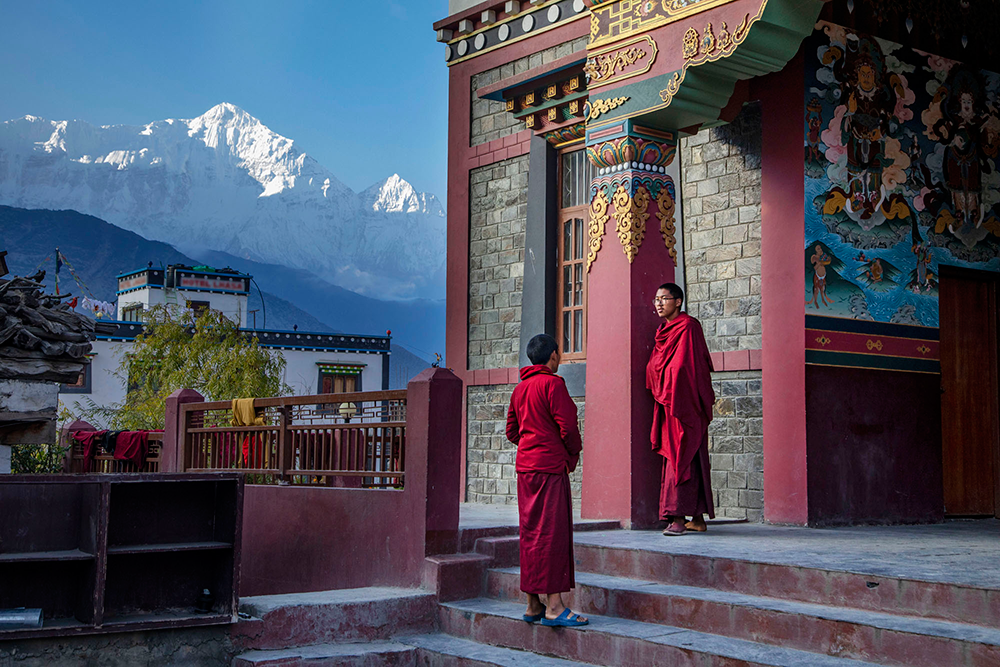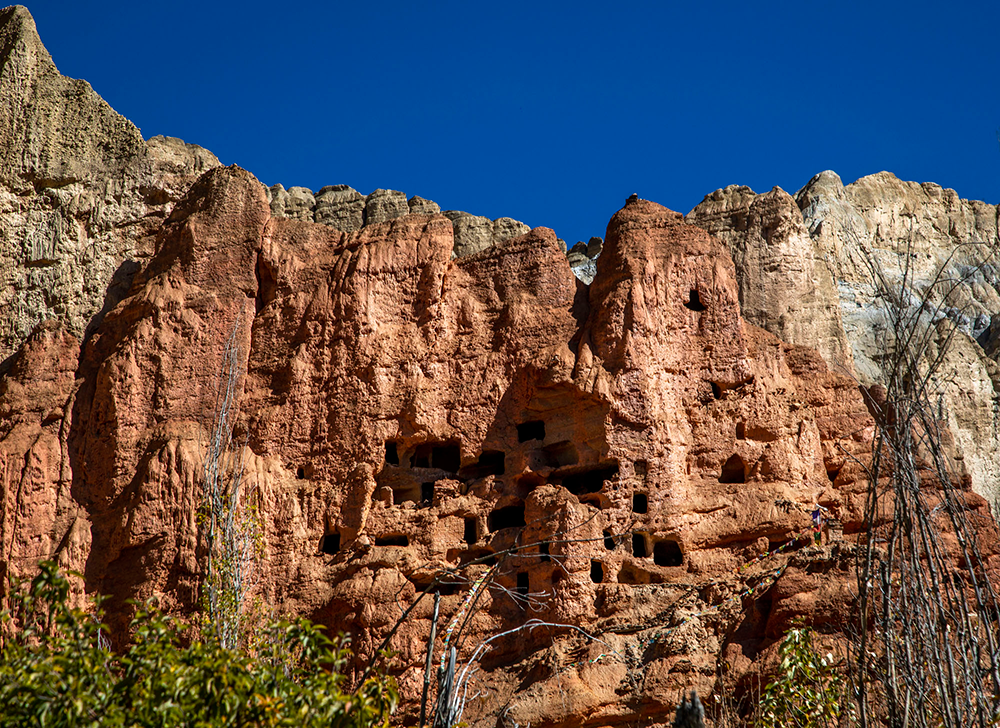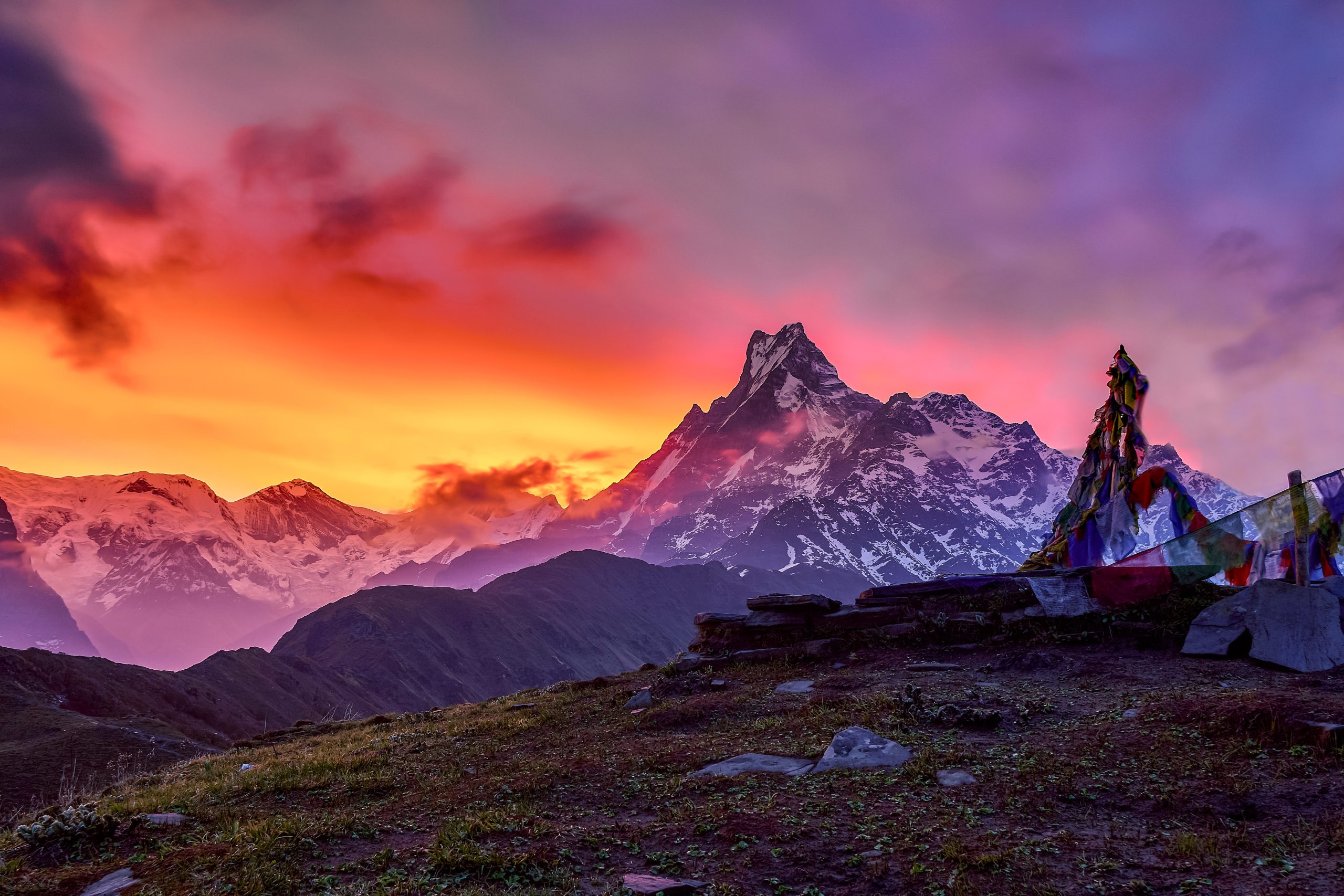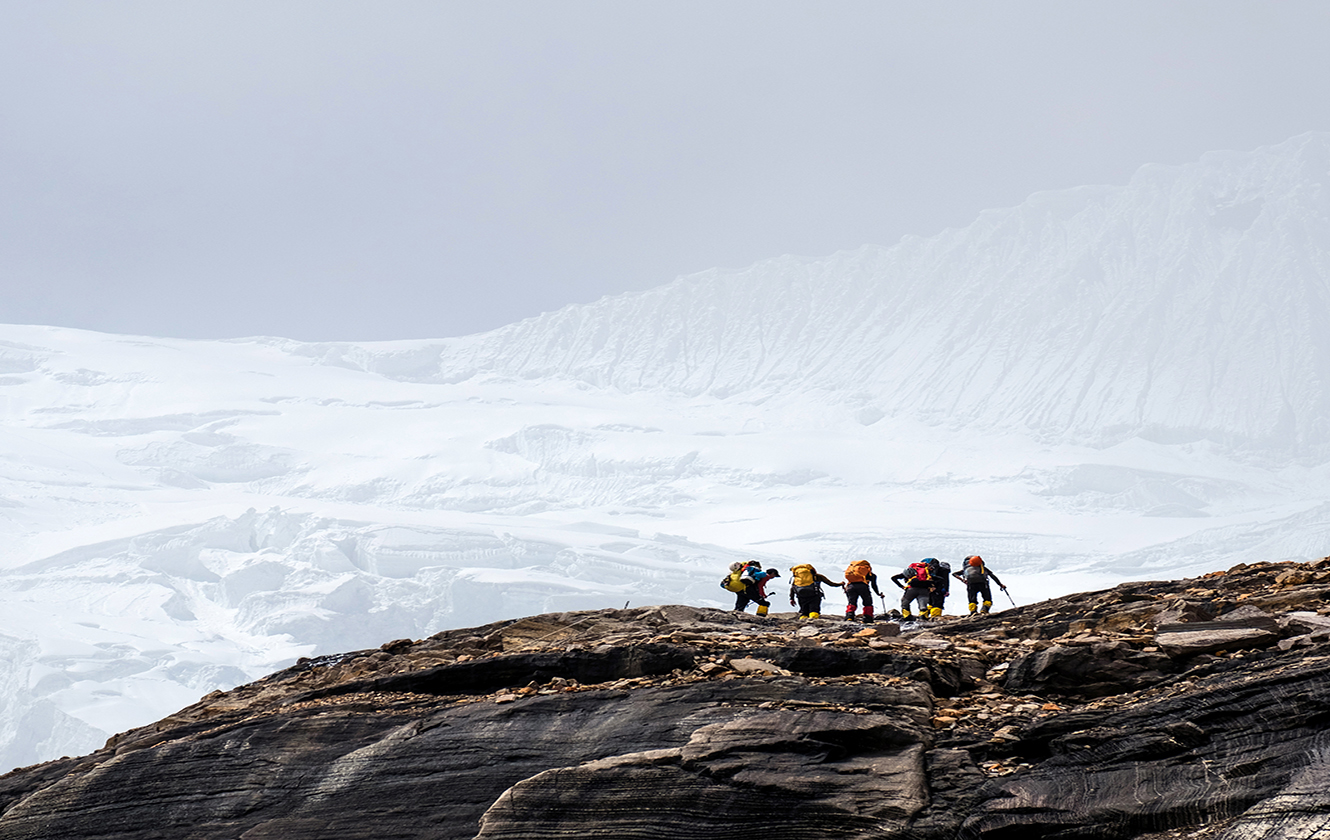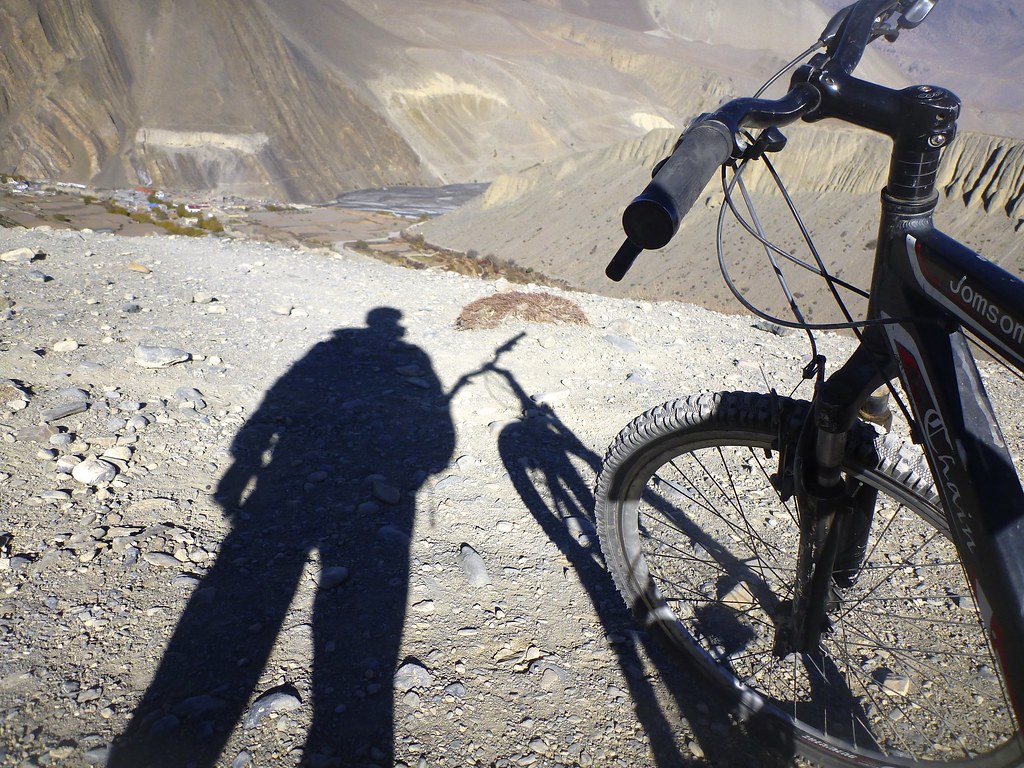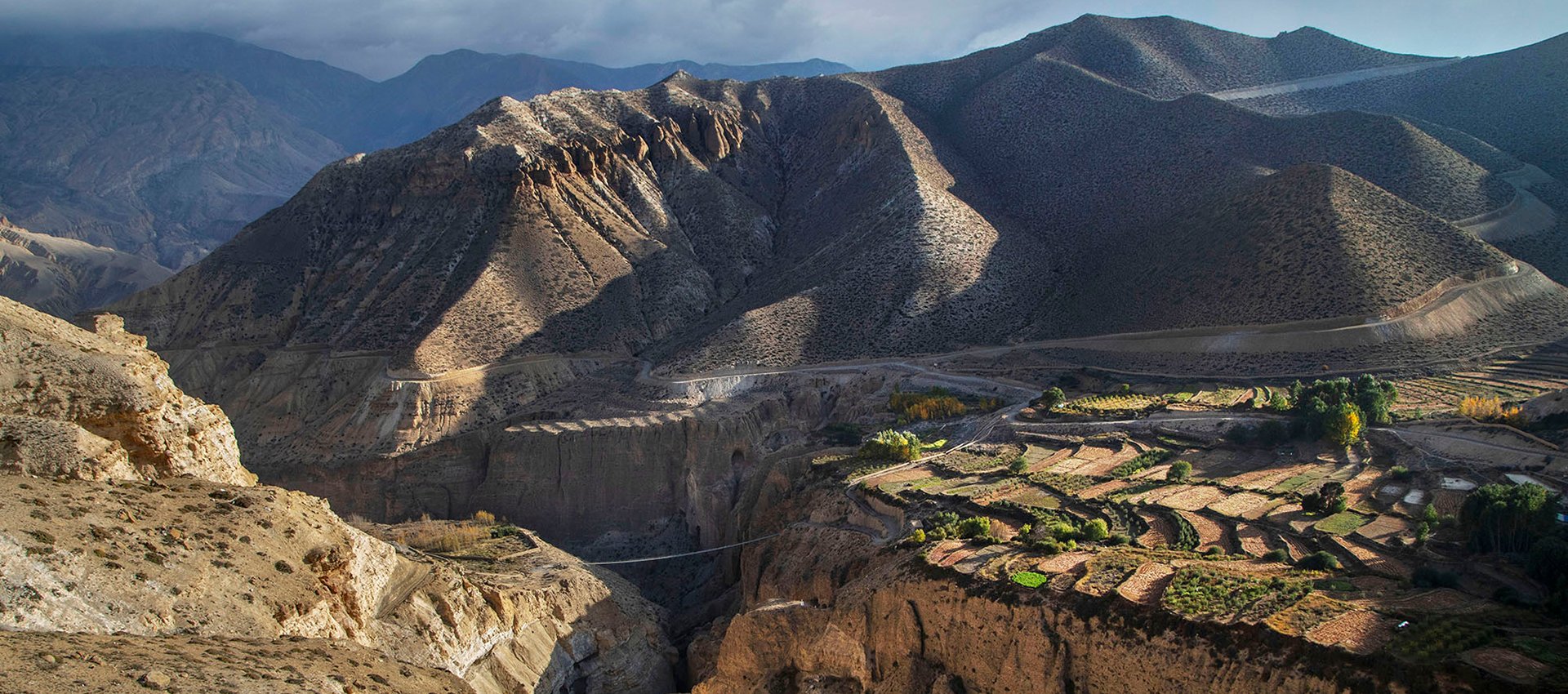
Lo-Manthang “An Overland Journey to Upper Mustang”
- Home /
- Nepal /
- Trekking & Hiking /
- Annapurna Region /
- Lo-Manthang “An Overland Journey to Upper Mustang”
The Kingdom of Lo-manthang or Mustang situated at an altitude of 3770 m is an independent kingdom within Nepal and its King having allegience to the King of Nepal. Though the people call themselves Laobas- people from Lo, they are very much Tibetan and practice a sophisticated culture and economy. The King’s palace is an imposing 4 – storey building in the center of the walled city. It is the home of the present king – Jigme Parbal Bista. The Honorary title “Bist – a high caste title in Nepali” was conferred by the King of Nepal. Though his duties are largely ceremonial, he is respected by the people and consulted about many issues by villagers throughout Lo Despite the apparent squalour of Lo Manthang, the city is prosperous and maintains a strong sense of community.
Lo-Manthang village. The major Temples inside the walls are Champa Lakhang (God House) which houses the massive 45 ft. statue of Maitreva, the future Buddha, The red Thugchen Gompawith several large images of Sakyamuni, Avolokitesvara and Maitreya, and the The Chyodi Gompa of the Sakya sect which has several monks in residence and is the site of the annual Mani Rimdu festival in many which is referred as ‘tegi’ in Lomanthang. They are all supposed to have been built in 1420. Despite the apparent squalour of Lo Manthang, the city is prosperous and maintains a strong sense of community. Though the people call themselves Lobas- people from Lo, they are very much Tibetan and practice a sophisticated culture and economy. The King’s palace is an imposing 4 storey building in the center of city. It is the home of the late King – Jigme Parbal Bista. The Honorary title “Bista– a high caste title in Nepali” was conferred by the King of Nepal.
This is a restricted area. Foreign visitors have been allowed to the region since 1992, but tourism to Upper Mustang is regulated. Foreigners need to obtain a special permit to enter and cosing US$ 500.00 per person for first 10 days and additional US$ 50 per day for each additional day.
Mustang is rich in Buddhist culture similar to Tibetan People. So, it is an alternate way to experience the Tibetan culture and Landscape. Tiji Festival in Lo-Manthang is another attraction for tourist.
Route Map

Itinerary In Detail
-
Day 01: Arrival in Kathmandu (1,400 m / 4,592 ft.)
Upon arrival in Katmandu’s Tribhuvan International Airport, meet, assist and transfer to hotel. After welcome refreshments and room check in the hotel, there will be a short briefing and orientation about the trek
Eve: Trip briefing followed by welcome dinner at Authentic Nepali restaurant with culture program.
Overnight at Hotel.
-
Day 02: Obtain special permit and fly to Pokhara (827 m /2,712 ft.) – 25 min.
In the morning we will obtain your special trek / tour permit for Upper Mustang from department of Tourism. After obtaining the permit transfer to Kathmandu’s domestic airport to board the short flight to Pokhara.
This is an enchanting city nestled in the tranquil valley (827m) on the laps of the mighty Annapurna Himalaya Range. With its beautiful lakes, lush green surroundings and fantastic views of the Annapurna range including the Fish Tail Mountain; it is considered one of nature’s finest gifts to Nepal. Upon arrival transfer to hotel for some refreshment.
Eve: Stroll around colorful Lakeside bazaar and dine at nice restaurant.
Overnight at hotel.
-
Day 03: Drive to Tukuche (2,670 m / 8,757 ft.) – 137 Km / 7 hrs
Am: After breakfast leave Pokhara and drive towards Beni (approx. 70 Kilometers) on the Baglung Highway. At Mal Dhunga, leave the main highway by taking the right trail and follow a dusty graveled path all the way to Beni, the district headquarters of Myagdi District in Dhaulagiri Zone. It is located on the confluence of Kali Ghandaki and Myagdi rivers at an altitude of 799 meters and is a bustling town lined with stores, restaurants, hotels and various government offices. We stop for lunch here.
After lunch continue scenic off-road drive to beautiful Tukche village as we ascend gradually through the Kali Gandiki gorge, the deepest gorge in the world. There is a continuous change in the topography with every twist and turn until our arrival at Kalopani.
From here set out on the trail by following the Kali Gandaki River and passing the Thakali and Magar Villages to Dana (4750 ft. / 1446 m.) famous for its beautiful cascading waterfall. We continue to Tukche Village passing through other villages as Ghasa, Kalopani.
Tukuche situated at an elevation of 2,670 meters on the bank of Kaligandaki River. Tukuche is famous for its apple orchards and apple products. This large Thakali village exhibits the typical Thak Khola architecture of flat roofs and narrow paved alleys and passageways. It also has a local distillery, where they produce famous Brandy.
Dinner and overnight at lodge.
-
Day 04: Explore Tukuche, Marpha Village and drive to Muktinath & stay overnight in Kagbeni (2,840 m / 9,315 ft.) 60 Km / 5~6 hrs.
After breakfast we will walk around Tukuche village and proceed to Marpha which is another Beautiful village and also has a Monastery.
After a short break at Marpha continue the drive towards Jomsom through the dusty graveled “off” road passing smaller settlements and apple orchards. There are excellent views of Mt. Nilgiri and the Kali Gandaki River flows on the right hand side of the trail. After Jomsom continue drive to Muktinath. The road from Jomsom to Muktinath is recently paved.
Visit Muktinath Temple
The Muktinath Temple is a sacred place both for Hindus and Buddhists and is located at an altitude of 3,710 meters at the foot of the Thorong La (5,416 m / 17,764 ft. Pass), Mustang district. The site is close to the village of Ranipauwa, which sometimes mistakenly is called Muktinath as well.
The Hindus call this sacred place Mukti Kshetra, which literally means “Place of Salvation”. This temple is considered to be the 105thamong the available 108 Divya Desam. The ancient name of this place, before the Buddhist origin was known as Thiru Saligramam.
In Muktinath-Chumig Gyatsa all the elements are represented and for this and reasons unseen, yogis from both religions do their meditation at Muktinath.
For Tibetan Buddhists, Muktinath (ChumigGyatsa) is a place of Dakinis (goddess known as Sky Dancers). It is of great importance for Buddhists as Chumig Gyatsa is one of the 24 Tantric places. Later drive to beautiful Kagbeni Village, which is the gateway to Upper Mustang.
Kagbeni at an altitude of 2,840m / 9,315 ft. is a fascinating medieval village with closely packed mud brick houses, dark alleys and imposing chortens lies along the Around Annapurna Trekking route and is the gateway to Upper Mustang. The village stands in a little green oasis dominated by its red monastery. Though the village has a very medieval look, it can provide all the modern amenities that a traveler requires. This is the only village after Jomsom where there is an internet facility for communication with the outside world. This village also boasts of a Monastery. The monks here are of the yellow hat or the Gelukpa Sect and have only recently opened their monastery to visitors with a legitimate entrance fee of Rs. 100, which they collect for the maintenance of their school.
Dinner and overnight at lodge.
-
Day 05: Drive to Geling via Samar (3,520 m / 11,546 ft.) - 45 km / 4 hrs
After completing the permits work we continue our drive to Geling. As we pass Kagbeni village we will be driving on the bank of Kali Gandaki River. Kali means (Black) and the water of the river are black in color. As we drive on we will come to the small village settlement knows as Tangbe, which has couple of house and tea house for the trekkers and travelers. As we pass through the Tangbe village, after 20 to 25 minutes drive we will come to another human settlement known as Chukksang village which is famous for beautiful fields of barley, buckwheat, wheat and apple orchards
We continue drive through the bank of Kaligandaki River. Before reaching to Chele there is a Steel foot bridge on Kaligandi River. This bridge is quite small one and it is normally used by the villagers and the trekkers. Cross the river and start ascend towards Samar Village for lunch. After some rest continue to Gelling village passing through the beautiful landscaped of Upper Mustang.
Overnight at teahouse lodge.
-
Day 06: Drive to Lo-Manthang via Tsarang (3,700 m / 12,136 ft.) - 35 km / 3 hrs.
After breakfast met by the rest of the team and continue the ride to Lo-Manthang. After crossing Geling we continue our ride to Ghami.
After crossing Ghami we drive to Tsarang via Nyi La Pass (3,950 m / 12,956 ft. Before the pass we will pass through
the longest Maniwall of Nepal, which is painted by Red, white and black colors. Descend down to Tsarang at 3520 m. It is a maze fields willow trees and houses separated by stonewalls. The huge 5 storied White Dzong and Red Gompa is perched on the east end of the village. The Gompa houses a collection of statues and thankas as well as many large paintings of seated Buddhas. Stop here for lunch and excursion.
After excursion continues drive to Lo-Manthang on the road will pass through the Big & very impressive Chorten and Lo Dry La River. Upon arrival check in at a lodge.
Eve: Explore around Lo-Manthang.
Dinner and overnight in Lo-Manthang.
-
Day 07: Horse ride excursion to Chonup & Chosar village
There are two valleys above Lo Manthang. A day hike to the North of Lo (Garphu/Nyphu) is Worthwhile. There are some interesting cave, monasteries in Garphu and Nyphu and numerous caves with dwellings inside them. On the way back, hike up-to the ruins of Ketcher Dzong for wide panoramic views of the valleys to the North and South.
Horses are available for hire in Lo Manthang and it is possible to make a circuit to the villages in the East and West valleys (Chonup Chosar) in a single day. Starting from Lo, begin towards to the North-West, visiting the village of Tingkhar – the site of the summer palace, Kimling and Phuwa as well as the Namgyal Gompa – the monasteries of victory, is in the west. We also visit Namdol before crossing the pass to Chosar (east valley, the site of the high school, and then head down to Garphu and Nyapu Gompas. This is the main trading route to Lhasa. It was used over the centuries by pilgrims, apostles, robbers and invaders and along the trail lies numerous fort ruins.
Dinner and overnight at teahouse lodge.
-
Day 08: Drive back to Kalopani (2,430 m / 7,970 ft.) via Kagbeni and Jomsom – 125 Km / 6 hrs.
After breakfast, start return Journey back to Kalopani.
Dinner and overnight at teahouse lodge.
-
Day 09: Drive back to Pokhara
After breakfast start scenic drive back to Pokhara.
Dinner and overnight at teahouse lodge.
-
Day 10: Spend a leisure day in Pokhara.
Pokhara is an enchanting city nestled in the tranquil valley (827m) on the laps of the mighty Annapurna Himalayan Range. With its beautiful lakes, lush green surroundings and fantastic views of the Annapurna range including the Fish Tail Mountain; it is considered one of nature’s finest gifts to Nepal.
There are so many things to do in this beautiful town, you can just walk around to Lakeside Bazaar or go for sightseeing. Pokhara also offer many kinds of Adventure activities such as Paragliding, Zip lining, Helicopter flight, Ultra-light flight etc.
Overnight at hotel.
-
Day 11: Fly to Kathmandu and sightseeing tour.
After breakfast, transfer to nearby Pokhara domestic airport to bard the short scenic flight to Kathmandu.
Upon arrival proceed for a sightseeing tour of Bhaktapur City, literally the “City of Devotees”, is renowned for its elegant art, fabulous culture, colorful festivals, traditional dances and the typical Newari lifestyle. Here explore the Royal Palace, the Golden Gate, the entrance to the Palace of 55 Windows, known as the most significant piece of art in Nepal. Then visit the highest temple in the entire Kathmandu Valley- the Nyatapola Temple. This is also listed on a UNISCO world heritage site.
Eve: Farewell Dinner
-
Day 12: Final departure from Nepal.
Free until final departure transfer to Kathmandu’s International Airport.
12 Days From
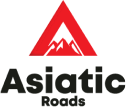
Any Question?
Feel free to call our travel experts.
+977 9851189018, +977 9801089018
info@asiaticroads.com
Accomodations
Accomodation (Hotels envisaged or similar)
| Kathmandu | Hotel | 1 | BB |
|---|---|---|---|
| Pokhara | Hotel | 1 | BB |
| Tukuche | Tea House | 1 | FB |
| Kagbeni | Tea House | 1 | FB |
| Geling | Tea House | 1 | FB |
| Tsarang | Tea House | 1 | FB |
| Chonup&Chosara Village | Tea House | 1 | FB |
| Kalapani | Hotel | 1 | BB |
| Pokhara | Hotel | 1 | BB |
| Kathmandu | Hotel | 1 | BB |
12 Days From

Any Question?
Feel free to call our travel experts.
+977 9851189018, +977 9801089018
info@asiaticroads.com
Additional Information
-
Clothing & Equipments
WHAT TO WEAR:
Light clothing is only for short treks up to seven days at altitudes up to 6000ft (1830m) during fall (autumn) from September to November and in spring between March to May. The other months at all altitudes will be cold and at most times the temperatures will be below zero.
Footwear:
You will need hiking boots with ankle support, sneakers for flat trails, and flip-flops or chappals for use around the camp/lodge.
Clothes:
Shirts, T-shirts (4), blouse, etc., for daywear and a woolen shirt/T-shirts for evenings.
MEN:
Shorts, cotton trousers, jeans, sweatpants (recon-mended), etc.
Undergarments & Socks:
Thermal underwear and inner trousers for the above 7,000 ft. treks. Thick trek socks.
Warm Clothes:
A light sweater, a windcheater or light lined/padded jacket, and a down jacket or parka for above 7000 ft. treks. Woolen thick cap and warm gloves.
Sun / Rain:
Rain gear or umbrella and a sun hat are essential. Global warming has led to freak weather conditions and it has become more and more difficult to predict weather conditions.
Note: Umbrellas are cheap and easily available in Kathmandu.
HOW TO PACK
In The Day Pack: In the Duffel Bag: Sunglasses Towels Moisturizing/Sunscreen lotion Spare batteries Prescribed medicines Toiletries Flashlight washing soap Camera and spare film Spare clothes all wrapped in plastic bags Binoculars-optional Reading Reference book/Notebook Pencil/Pen / Water bottles/ Trek permits Toilet paper Umbrella/rain gear / Sweater Note: Sleeping bags can be purchased in Kathmandu. It is even available on hire upon request. However, we request our clients to bring their own sleeping bags because of hygiene.
-
How To Train For Trekking
Many people worry that they are not fit enough for long treks, especially in the challenging Himalayan region. However with the right training realistic expectations, and healthy on-trail habits, Himalayan treks is possible for most of healthy hikers. Here are some tips for how to train for trekking in the Himalayas.
START EARLY
You will need to build muscle, endurance and your cardiovascular system. Do no put of training until a month before you leave. It is worth splurging a bit and hiring a trainer who can design a program specifically for what you are doing. If he or she can see you’re hiking Itinerary, even better. They will likely develop a plan that spans several months. Stick with it.
USE A COMBINATION OF EXERCISES
If you choose to develop you own plan (after careful research), use a variety of exercises. Including trail running ensures you will be confident on your feet on uneven terrain. You will also want to include box steps on boxes of varying heights while holding weights. Though you need to build strength to hike 4 to 9 or 10 hours in a day, it is also worthwhile to include sprint intervals, either running or on a bike. This improves your recovery time. Try short bursts of pushing a heavy sled to build your CV system to ensure you don’t feel like throwing up on the trail!! And do not forget your Arms! You should use your trekking poles, and these may give you more of a forearm workout tan you anticipate. Try some triceps extensions, as well as pull ups, rows and dips for your shoulders and back. You will, after all, be carrying a day pack.
STAYING HEALTHY ON TREK
Water is most important part of your hike. Drink at least 3/4 liters of water a day. Ensure yourself you are rehydrating all the time (Dehydration is one of the reason of Acute Mountain Sickness) . Stretch your calves, hips and gluteus any time you stop. This will minimize morning soreness and prevent injury. Bring bio freeze, icy hot, or Tiger Balm for rubbing on sore muscles at night (Tiger Balm is easily available in Kathmandu & Pokhara); these are practically helpful on and behind my knees after steep down hills. No matter what your diet is at your home, eat on a trail. All the teahouses serve pasta, rice, and pizza. Take an advantage of all those carbs. Avoid having alcoholic liquor especially while going up in the High Altitude.
WHEN YOU FINISH
The work you have done hiking will affect you even particularly painful, as your legs may be very restless for several days. Wear compression socks and try to get an aisle seat so you can walk around. After all this, you will definitely come away with a sense of exactly how strong your body is.
-
Notes For Trekkers / Travellers
Dear Guests,
Namaste & warm Greetings from Nepal!!We are very pleased that you have inquired for your trek with Asiatic Roads. The idea of this hand out is to furnish you with information for your pre-trek preparations.
Firstly, we recommend that you travel light. A good-sized duffel bag with a top length zipper that can lock is best, together with a day pack for carrying personal items on the trek. An extra smaller bag would be handy to carry back your souvenirs after the trip.
AFTER ARRIVAL IN KATHMANDU
1. TREK BRIEFING:
On your arrival in Kathmandu, we will arrange to meet for a pre-trek briefing. Full information on all aspects of your trek, questions and doubts will be discussed. On trek your Sherpa leader (sardar) will give you more details about the route, villages, people and other information regarding the trek.2. PACKING:
You may leave behind part of your luggage in your hotel or our locker room before the trek, in Kathmandu. All baggage is to be clearly marked and locked. Kindly refrain from carrying or wearing valuables on the trek. You may leave them behind at the safety deposit box at your hotel or with us.3. HOW TO PACK:
Your clothes and equipment should fall into the following 4 categories:1. What you are going to leave behind in Kathmandu.
2. What you are going to wear on the trail.
3. What you are going to carry in your day pack.
4. What you would like the porters to carry for you.Excess clothes and luggage can be stored in your hotel’s storeroom, and valuables in the safety deposit box. Please label your luggage and make sure to take a receipt from the front desk of your hotel for all the things you would like to leave behind while you are away.
ON TREK
1. YOUR STAFF ON THE TRIP:
Will consist of one English speaking Sirdar (Guide) and Assistance Guide or Escort who will be wholly responsible for the execution of the trip once it hits the trail. He will be assisted by Sherpa(s) as necessary.2. WHAT TO CARRY DURING THE TREK:
Your daypack, preferably waterproof should be light, small and comfortable. All small personal items like toilet paper, water bottle, medicines, extra shirt, light warm wears, rain gear, gloves etc. that may be needed for the days trek should be packed. Your duffel will be carried by porters who may not be with you at all times.3. MONEY ON TREK:
You may want to buy drinks at wayside shops and souvenirs from the natives. Small change should be carried. As customary, we can help discuss in detail in the pre-trek briefing.TREK KIT LIST
WHAT TO WEAR:
Light clothing are only for short treks up to seven days at altitudes up to 6000ft (1830m) during fall (autumn) from September to November and in spring between March to May. The other months at all altitudes will be cold and at most times the temperatures will be below zero.Footwear:
You will need hiking boots with ankle support, sneakers for flat trails and flip-flops or chappals for use around the camp/lodge.Clothes:
Shirts, T-shirts (4), blouse, etc., for daywear and a woolen shirt/T-shirts for evenings.MEN: Shorts, cotton trousers, jeans, sweat pant (recon-mended) etc.
Undergarments & Socks:
Thermal underwear and inner trouser for the above 7,000 ft. treks. Thick trek socks.Warm Clothes:
A light sweater, a windcheater or light lined/padded jacket and down jacket or parka for above 7000 ft. treks. Woolen thick cap and warm gloves.Sun / Rain:
Rain gear or umbrella and a sun hat is essential. Global warming has led to freak weather conditions and it has become more and more difficult to predict weather conditions.
Note: Umbrellas are cheap and easily available in Kathmandu.HOW TO PACK
In The Day Pack: In the Duffel Bag:
Sun glasses Towels
Moisturizing/Sun screen lotion Spare batteries
Prescribed medicines Toiletries
Flash light washing soap
Camera and spare film Spare clothes all wrapped in plastic bags
Binoculars-optional
Reading Reference book/Note book
Pencil/Pen / Water bottles/ Trek permits
Toilet paper
Umbrella/rain gear / SweaterNote: Sleeping bags can be purchased in Kathmandu. It is even available on hire upon request. However, we request our clients to bring their own sleeping bags because of hygiene.
ADDITIONAL ITEMS:
For most treks from mid-November till mid-February and for those above 10,000 ft. /3000 m., in Spring and Autumn, anti-dazzle glasses or goggles with side attachments are recommended and High altitude food supplements (favorite snacks) if necessary.IMPORTANT NOTE:
In the event of an accident or serious ailment on a trek, helicopter evacuation can be arranged. The helicopter fare with 10% service charge and the hospital/medical charge will have to be cleared before departing from Kathmandu. A risk, release and guarantee form has to be signed before leaving on a trek with us.INSURANCE:
There are no reliable medical insurance policies in Nepal for foreigners. We strongly recommend you to take comprehensive holiday insurance in your own country covering adventures involving some elements of risk, especially to cover Emergency Helicopter Evacuation.BOOKS:
Trekking in the Nepal Himalayas by Stan Armington published by the Lonely Planets books provides you comprehensive information on all matters regarding trekking in Nepal
The Trekkers Peaks of Nepal by Bill O’Connor published by Crow Wood press in U.K. provides you with information on all matters regarding climbing peaks in Nepal.
Trekking in Nepal by Toru Nakano published by Allied Publishers gives you some insight into some important trekking areas in Nepal. A map of Nepal is enclosed in the book. -
Visa Information
Tourist Visa
Immigration Offices, under Department of Immigration have been facilitating tourists flying to Nepal by providing Visa on Arrival. ‘On Arrival’ visa procedure is very quick and simple. You can expect some queues during peak Tourist season. If you wish to skip those queues, you can also consider getting Visa from Nepalese Diplomatic Missions stationed abroad prior to your arrival. Choice is yours.
If you have obtained visa from Nepalese Diplomatic Missions, then you must enter Nepal within six months from the visa issued date. Your total stay is counted starting from the day you enter into Nepal.
Visas obtained on Arrival at the Entry and Exit points are ‘Tourist Visas’. They bear multiple Re entry facility. Tourist Visa ‘On Arrival’ is the only entry visa to Nepal. If you are visiting Nepal for the purposes other than Tourism (sightseeing, tour, travel, mountaineering, trekking, visiting friends and families), you should still get ‘ Tourist Visa’ to get into the country. However, you must change the category of visa as per your purpose and length of stay in Nepal from Department of Immigration by producing required documents.
Nationals of following countries are requested to acquire Visa prior their arrival from their nearby Diplomatic missions (Embassies/consulates) of Nepal Government.
- Nigeria
- Ghana
- Zimbabwe
- Swaziland
- Cameroon
- Somalia
- Liberia
- Ethiopia
- Iraq
- Palestine
- Afghanistan
- Syria
- Refugees with travel document
Please follow these simple procedures for Tourist Visa on Arrival at the airport (TIA) if you have not acquired Visa prior to boarding the plane.
- 1st Step
- Fill in ‘ Arrival Card ‘
- Fill in Online ‘Tourist Visa ‘form ( you can fill it up prior to your arrival visiting our official website Department of Immigration / fill it up using Kiosk machines upon your arrival at the airport). If you fill it from the website, you will get submission Receipt with barcode, please print it out and bring it along for acquiring visa. It works for fifteen days and becomes invalid then after. If so, you will have to fill it up again.
- 2nd Step
- Make payment at the bank according to your visa requirement ( 15/30/90 Days)
- Get the receipt
While you can use different modes of payments (at visa fees collection counter), we advise you to carry some cash to be on the safe side.
On Arrival Visa Fee at Entry Points
15 Days – 30 USD
30 Days – 50 USD
90 Days – 125 USD
- 3rd Step
- Proceed to the Immigration Desk with your online form, payment receipts and your passport
- Hand in your documents to immigration officer for visa processing. He/she issues visa to you upon his/her satisfaction.
Visa Extension Fee
- Tourist visa extension is done for minimum 15 days with USD 45 and USD 3 per day for additional days.
- In the case of delay less than 150 days additional USD 5 per day as late fine.
Gratis Visa (Visa for Free)
Gratis Visa is issued free of cost in case of following categories of Visa applicants:
- Children below 10 years except US citizens
- Up to 30 days for SAARC Citizen (except Afghanistan) visiting Nepal for the first time in a given visa Year. Afghan citizen are eligible for Gratis Visa on Arrival only upon the recommendation of Department of Immigration. If you are an Afghan citizen, you can request concerned institution inviting you to Nepal for necessary paperwork with Department of Immigration to get you Gratis Visa ‘On Arrival’.
- Non Residential Nepalese(NRN) card holder ( issued by MoFA /Nepalese diplomatic missions abroad)
- Chinese Nationals for 150 days
Officials from
- Thailand – Exemption up to 90 Days
- Russian Federation – Exemption up to 90 Days
- People’s Republic of China – Exemption up to 30 Days
- Federal Republic of Brazil – Exemption up to 90 Days
- Myanmar – Exemption up to 90 Days
- Vietnam – Exemption up to 90 Days
- Cambodia – Exemption up to 30 Days
- Mongolia – Exemption up to 90 Days
- Jordan – Exemption up to 90 Days
- State of Israel – Exemption up to 90 Days
- Georgia – Exemption up to 90 Days
- State of Qatar – Exemption up to 90 Days
do not need Entry Visa based on reciprocal visa waiver Agreement
Visas of all kinds including ‘Gratis’ issued at the Airport are Tourist Visas. Contact Department of Immigration for extending your visa or changing the category of your visa. Tourist Visa extension can be done from Immigration Office, Pokhara too. Non tourist visa extension can be done only at Department of Immigration (if eligible) for a period of maximum one year (except business visa).
12 Days From

Any Question?
Feel free to call our travel experts.
+977 9851189018, +977 9801089018
info@asiaticroads.com
Reviews
In my 2 week stay, John was very professional and took me around to experience all that Kathmandu and surrounding areas has to offer. Sites were seen and many locals were met through John’s network.

Steven Stone
TravellerIn my 2 week stay, John was very professional and took me around to experience all that Kathmandu and surrounding areas has to offer. Sites were seen and many locals were met through John’s network.

Steven Stone
Traveller12 Days From

